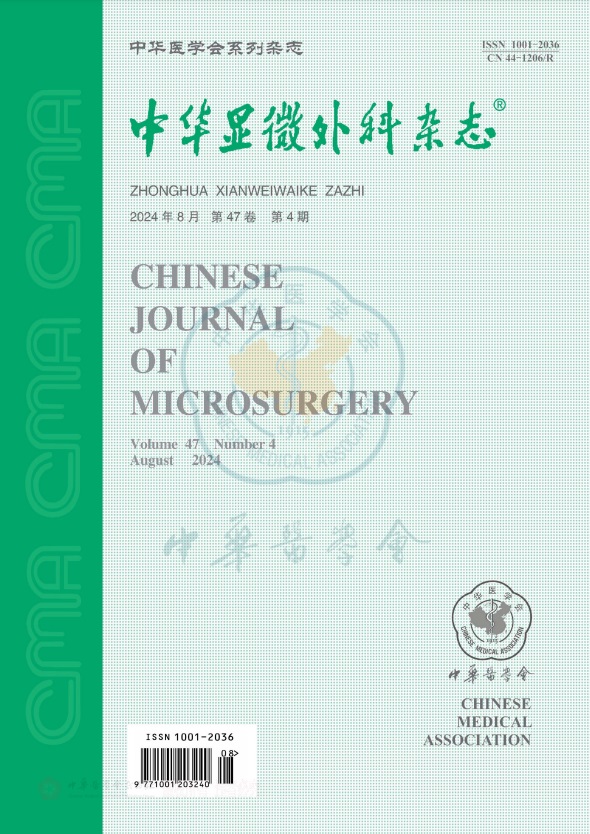V-Y advancement flap based on the double perforators of the posterior tibial artery for reconstruction of small-area tissue defect in the achilles tendon
引用次数: 0
Abstract
Objective To explore the clinical effect of complete transposition of arteriovenous in free flap artery crisis. Methods From October, 2009 to April, 2017, 13 cases of extremities tissue defect were repaired with free flaps. The intractable arterial crisis appeared after transplantation. Repeated anastomosis vessels were adapted but it was not relieved. Then the complete transposition of arteriovenous was adapted in the flaps. Namely the vein of the flap was anastomosed with the arterial in the recipient site to reconstruct the blood supply, and the arterial of the flap was anastomosed with the vein in the recipient site to reconstruct recirculation. Ten cases of hand defect and 3 cases of crus defect were repaired by 5 low abdominal flaps and 8 anterolateral thigh flaps. The tissue defect area was 16 cm×7 cm-6 cm×4 cm and the flap area was 18 cm×8 cm-7 cm×4 cm. Results Ten flaps survived completely, the other 3 flaps almost survived that scab healed in 1 case and skin grafted in 2 cases. The flap for skin color was from purple red to dark red, and finally close to normal, and skin flap edge would have different degrees of ecchymosis; the bleeding from the incision of the skin flap was from dark red to bright red; the swelling of the flap was obvious in the early stage and the later swelling subsided. All cases were followed-up from 6 months to 32 months with an average of 16 months. The wounds healed well. The flaps had a clear boundary and soft texture. Conclusion Complete transposition of the arteriovenous system can be used as an alternative in the presence of intractable arterial crisis after free flap transplantation, to save the flap and to reduce the trauma to the patient. Key words: Free flaps; Arterial crisis; Transposition of the arteriovenous; Repair以胫后动脉双穿支为基础的V-Y推进皮瓣重建跟腱小面积组织缺损
目的探讨动静脉完全转位治疗游离皮瓣动脉危象的临床效果。方法2009年10月~ 2017年4月对13例四肢组织缺损患者行游离皮瓣修复术。移植后出现难治性动脉危象。重复吻合血管适应,但未缓解。皮瓣采用动静脉完全转位。即皮瓣的静脉与受体部位的动脉吻合重建供血,皮瓣的动脉与受体部位的静脉吻合重建再循环。应用5个腹下皮瓣和8个股前外侧皮瓣修复10例手部缺损和3例小腿缺损。组织缺损面积16 cm×7 cm-6 cm×4 cm,皮瓣面积18 cm×8 cm-7 cm×4 cm。结果10个皮瓣完全成活,其余3个皮瓣基本成活,痂愈合1例,植皮2例。皮瓣皮肤颜色由紫红色到深红色,最后接近正常,皮瓣边缘出现不同程度淤斑;皮瓣切口出血由深红色变为鲜红色;皮瓣早期肿胀明显,后期肿胀消退。所有病例随访6 ~ 32个月,平均16个月。伤口愈合得很好。皮瓣边界清晰,质地柔软。结论在游离皮瓣移植后出现难治性动脉危象时,完全转置动静脉系统可作为一种替代方法,保存皮瓣,减少对患者的创伤。关键词:自由襟翼;动脉危机;动静脉转位;修复
本文章由计算机程序翻译,如有差异,请以英文原文为准。
求助全文
约1分钟内获得全文
求助全文
来源期刊
CiteScore
0.50
自引率
0.00%
发文量
6448
期刊介绍:
Chinese Journal of Microsurgery was established in 1978, the predecessor of which is Microsurgery. Chinese Journal of Microsurgery is now indexed by WPRIM, CNKI, Wanfang Data, CSCD, etc. The impact factor of the journal is 1.731 in 2017, ranking the third among all journal of comprehensive surgery.
The journal covers clinical and basic studies in field of microsurgery. Articles with clinical interest and implications will be given preference.

 求助内容:
求助内容: 应助结果提醒方式:
应助结果提醒方式:


